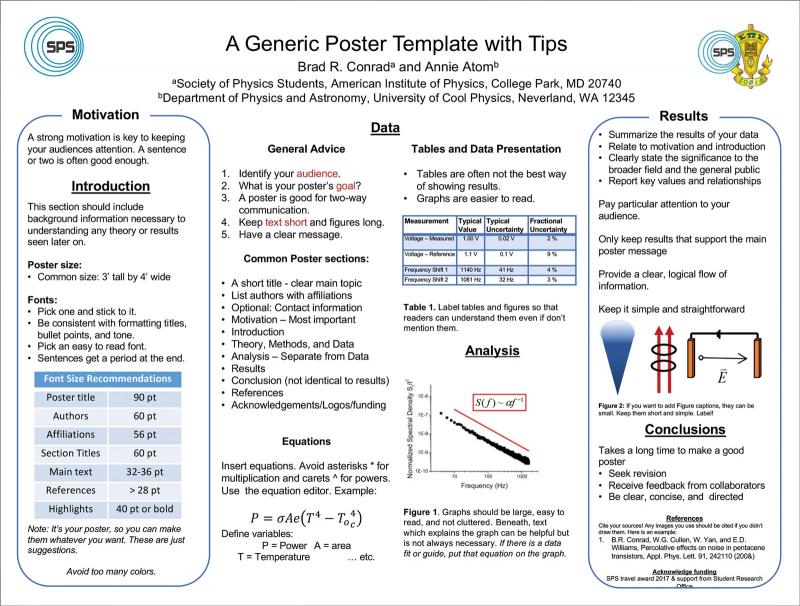Seven Suggestions on How to Make an Awesome* Poster
Spring
2017
Feature
Seven Suggestions on How to Make an Awesome* Poster
*People’s preferences vary for posters, so make sure you get expert opinions before you print.
By:Brad R. Conrad, PhD, Directory of Society of Physics Students and Sigma Pi Sigma

View or print a PDF version of this article
1. Tailor your presentation to your audience!
Experts within the field
- Shorter background
- Identify field significance
- Key results
- Highlight new techniques
Colleagues
- Stress background
- Clear presentation
- Detailed processes & data analysis
General public
- Strong background
- Clear motivation
- Relate to their background
- Answer a clear question
2. Select a goal for your poster
- Your poster is a visual guide to reference while you present.
- The poster should not distract the audience but instead be a tool to transfer information.
- If the poster is meant to hang in a hallway or lab for a long time, it is OK to include more detail.
3. Purpose
- Posters are well-suited for presenting a logical argument to a small number of people.
- Conversations often end up being bidirectional and people will be talking to you, not reading the poster very much.
- Posters are fantastic for in-depth, technical discussions.
- Develop a clear, singular message.
- Identify what you want your audience to take away.
4. Figures & Phrases
- Figures should be large, clear, and well labeled.
- People will not read paragraphs of text.
- Use phrases and bullet points.
- Keep text to the essentials
- Include only just enough information for someone to follow along if you are not there.
5. Professionalism
- Don’t ignore anyone.
- Let people ask you questions.
- Don’t speak over them.
- Never eat while presenting.
- Don’t have note cards.
- Thank people for speaking with you.
6. Focal points
- Motivation – Provide a clear motivation for your research.
- Make sure you have all the necessary figures You never want to think in the middle of your poster session, “Oh, I wish I had a figure which explained that.”
- You need to practice your poster explanation several times. Ask both colleagues & non-experts.
7. Design
- Posters are read left to right, top to bottom.
- Three column designs are common (see figure).
- Less is more. Stick to the message.
- Results and conclusion go on the right side of a poster.
- Put references and acknowledgments at the bottom.
- Either make all your own figures (preferred), or cite them appropriately. Avoid plagiarism.
- Favor graphs over tables.
For more information on preparing an effective presentation, see “Preparing an Effective Presentation," also in this issue.



